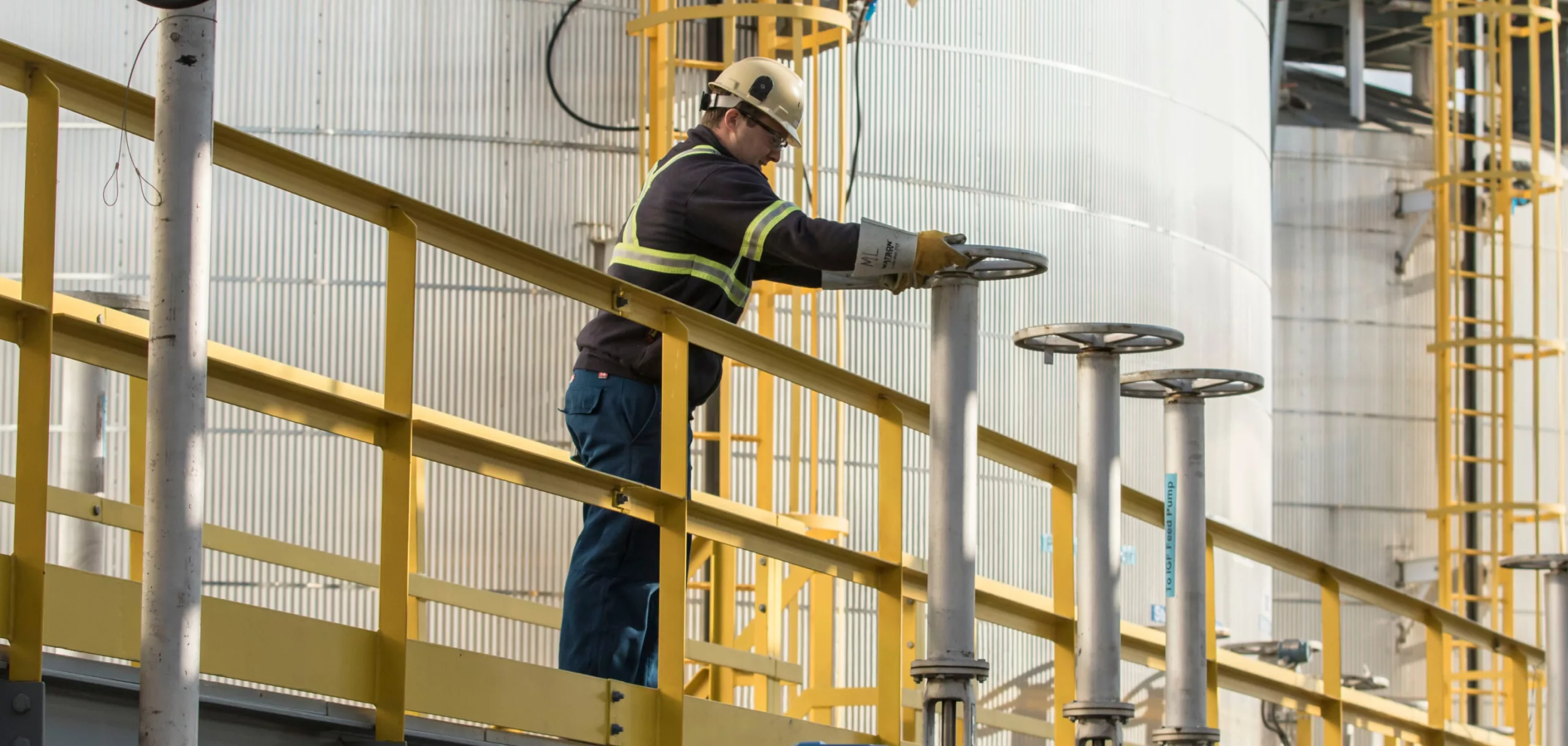Carbon capture and storage (CCS)
Pathways Alliance members have proposed a carbon capture and storage network and pipeline that, when operational, would have the capacity to transport captured CO₂ from multiple oil sands facilities to a hub in the Cold Lake area of Alberta for permanent underground storage. The project proceeding is contingent upon obtaining sufficient fiscal and policy support and regulatory approval.
What is carbon capture and storage (CCS)?
CCS is a proven technology used around the world, including here in Canada.
Capture technologies are fitted to a large emission source, which makes it possible to capture CO₂ emissions so they don’t end up in the atmosphere. The CO₂ is pressurized and turned into liquid form, which can flow through a pipeline to a storage facility where it is stored deep underground. Captured CO₂ is typically stored between 1,000 and 2,000 metres beneath the Earth’s surface.
CCS has the potential to help prevent CO₂ created by industrial activities from entering the atmosphere, where it would otherwise contribute to the conditions that cause climate change.
The International Energy Agency, which provides data and analysis on the global energy sector, recognizes that CCS is an important technology to help reduce CO₂ emissions in the energy sector.
Alberta has experience and expertise in the safe construction and operation of large-scale CCS projects. For example, since 2012, the Quest Carbon Capture and Storage facility in northern Alberta has been demonstrating the ability to capture and store CO₂ from industrial sources. (Canadian Natural has Quest majority ownership of 90%.) Since 2015, the Quest facility has captured and permanently stored over 9 million tonnes of CO₂.
By working together and with governments, oil sands companies can keep advancing environmental innovation and projects, contributing to Canada’s economy and helping to provide a secure source of energy here and to the world.

Carbon capture, transportation and storage is a proven technology with the potential to improve emissions intensity from oil sands operations, and our members have the expertise to implement it now.
Kendall Dilling
President, Pathways Alliance

Carbon capture and storage safety
The proposed Pathways Alliance members’ CCS network and pipeline will have a multi-layered safety system based on decades of technical experience and scientific research.
CCS projects around the world
According to the Global CCS Institute’s 2024 report, there are 50 carbon capture and storage projects operating worldwide, with 44 projects currently under construction. Learn about some of these projects using the map and case studies below.
*Visuals for illustrative purposes only. Additional facilities not shown.
Click or tap on each hot spot to learn more
Case studies
These are just a few of the large-scale CCS projects currently operating around the world.
Quest CCS facility
The Quest CCS facility is part of the Athabasca Oil Sands Project (AOSP), of which Pathways member Canadian Natural owns a 90% interest. Quest has a capture capacity of more than one million tonnes of carbon dioxide (CO₂) per year3. The captured CO₂ is transported via pipeline to a facility where it’s injected and permanently stored in a deep aquifer, about two kilometres underground. The facility began operations in 2015.
Where
Alberta
When
2015
CO₂ captured to date
Over 9 million tonnes
Northern Lights project
Northern Lights is the transport and storage part of Norway’s Longship project, which includes capture of CO₂ from industrial facilities in the Oslo region. Northern Lights intends to ship the captured carbon dioxide to a terminal on the west coast and then transport the liquefied CO₂ by pipeline to an underwater storage location in the North Sea. They’ll also offer the storage to companies across Europe4. The first phase of Northern Lights is now completed, and work is underway for a second phase5. This will be the first cross-border, open-source CO₂ transport and storage infrastructure network6.
Porthos project
Porthos is a partnership between the Port of Rotterdam Authority, Gasunie and EBN (Energie Beheer Nederland)9. The project will transport CO₂ from industrial facilities in the Port of Rotterdam for permanent storage in empty gas fields beneath the North Sea. Short for Port of Rotterdam CO₂ Transport Hub and Offshore Storage, Porthos is the Netherlands’ first large-scale CO₂ transport and storage initiative10. Captured CO₂ will be transported via pipelines to an offshore platform and injected into depleted gas fields under the seabed. Currently under construction, the project aims to store 2.5 million tonnes of CO₂ annually11, with operations expected to begin in 2026.
Where
Netherlands
When
2026
Initial Capacity
Porthos will store about 37 million tonnes of CO2, which is about 2.5 million tonnes of CO2 per year for 15 years.12
The Northern Endurance Partnership (NEP)
The NEP is a collaborative project between several leading energy companies. The offshore pipeline network and storage will capture CO₂ from industrial facilities in northeast England, transport it by pipeline to the U.K. North Sea, and permanently store it deep underground in a saline aquifer.
It’s one of several CCS projects undertaken as part of efforts to reduce greenhouse gas emissions and meet the country’s net-zero carbon targets by 205013.
Where
United Kingdom
When
2028
Project capacity
up to 4 million tonnes of captured carbon dioxide emissions per year, rising to an average of up to 23 million tonnes by 2035 with future expansion of the East Coast Cluster.14
3 Government of Alberta, 2022
4, 6 Northern Lights Longship Project
5 Norway Ministry of Energy
7 Global CCS Institute, 2024
8 Equinor
9, 10 Porthos
13 UK Government, 2021
11, 12 Porthos CO₂ Transport & Storage, 2023
14 Equinor, 2024

